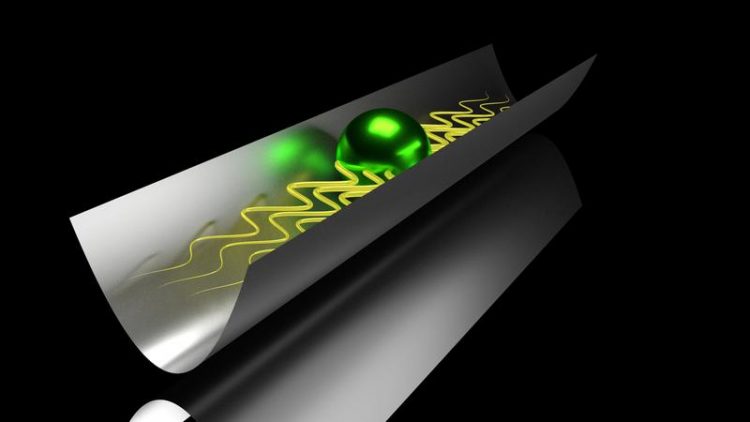Breaking Newton's Law

Physicists have observed an intriguing oscillatory back-and-forth motion of a quantum particle in a one-dimensional atomic gas. Florian Meinert
A ripe apple falling from a tree has inspired Sir Isaac Newton to formulate a theory that describes the motion of objects subject to a force. Newton’s equations of motion tell us that a moving body keeps on moving on a straight line unless any disturbing force may change its path.
The impact of Newton’s laws is ubiquitous in our everyday experience, ranging from a skydiver falling in the earth's gravitational field, over the inertia one feels in an accelerating airplane, to the earth orbiting around the sun.
In the quantum world, however, our intuition for the motion of objects is strongly challenged and may sometimes even completely fail. What about imagining a marble falling through water oscillating up and down rather than just moving straight downwards? Sounds strange.
Yet, that's what experimental physicist from Innsbruck in collaboration with theorists from Munich, Paris and Cambridge have discovered for a quantum particle. At the heart of this surprising behavior is what physicists call ‘quantum interference’, the fact that quantum mechanics allows particles to behave like waves, which can add up or cancel each other.
Approaching absolute zero temperature
To observe the quantum particle oscillating back and forth the team had to cool a gas of Cesium atoms just above absolute zero temperature and to confine it to an arrangement of very thin tubes realized by high-power laser beams. By means of a special trick, the atoms were made to interact strongly with each other. At such extreme conditions the atoms form a quantum fluid whose motion is restricted to the direction of the tubes.
The physicists then accelerated an impurity atom, which is an atom in a different spin state, through the gas. As this quantum particle moved, it was observed to scatter off the gas particles and to reflect backwards. This led to an oscillatory motion, in contrast to what a marble would do when falling in water. The experiment demonstrates that Newton's laws cannot be used in the quantum realm.
Quantum fluids sometimes act like crystals
The fact that a quantum-wave may get reflected into certain directions has been known since the early days of the development of the theory of quantum mechanics. For example, electrons reflect at the regular pattern of solid crystals, such as a piece of metal. This effect is termed ‘Bragg-scattering’. However, the surprise in the experiment performed in Innsbruck was that no such crystal was present for the impurity to reflect off.
Instead, it was the gas of atoms itself that provided a type of hidden order in its arrangement, a property that physicist dub ‘correlations’. The Innsbruck work has demonstrated how these correlations in combination with the wave-nature of matter determine the motion of particles in the quantum world and lead to novel and exciting phenomena that counteract the experiences from our daily life.
Understanding the oddity of quantum mechanics may also be relevant in a broader scope, and help to understand and optimize fundamental processes in electronics components, or even transport processes in complex biological systems.
The research was funded by the European Research Council (ERC) and the Austrian Science Foundation (FWF), the Institute for Advanced Study at TUM, the French National Center for Scientific Research (CNRS), as well as Harvard-MIT CUA, the National Science Foundation (USA), AFOSR, the Humboldt Foundation, and the Max Planck Institute for Quantum Optics.
Publication: Bloch oscillations in the absence of a lattice. Florian Meinert, Michael Knap, Emil Kirilov, Katharina Jag-Lauber, Mikhail B. Zvonarev, Eugene Demler, Hanns-Christoph Nägerl. Science 2017. DOI: 10.1126/science.aah6616
Contact:
Hanns-Christoph Nägerl
Department of Experimental Physics
University of Innsbruck
phone: +43 512 507-52420
email: christoph.naegerl@uibk.ac.at
Web: www.ultracold.at
Christian Flatz
Public Relations Office
University of Innsbruck
phone: +43 512 507 32022
email: christian.flatz@uibk.ac.at
http://dx.doi.org/10.1126/science.aah6616 – Bloch oscillations in the absence of a lattice. Florian Meinert, Michael Knap, Emil Kirilov, Katharina Jag-Lauber, Mikhail B. Zvonarev, Eugene Demler, Hanns-Christoph Nägerl. Science 2017
http://www.ultracold.at/ – Ultracold Atoms and Quantum Gases Group
http://www.uibk.ac.at/exphys/ – Department of Experimental Physics
Media Contact
All latest news from the category: Physics and Astronomy
This area deals with the fundamental laws and building blocks of nature and how they interact, the properties and the behavior of matter, and research into space and time and their structures.
innovations-report provides in-depth reports and articles on subjects such as astrophysics, laser technologies, nuclear, quantum, particle and solid-state physics, nanotechnologies, planetary research and findings (Mars, Venus) and developments related to the Hubble Telescope.
Newest articles

NASA: Mystery of life’s handedness deepens
The mystery of why life uses molecules with specific orientations has deepened with a NASA-funded discovery that RNA — a key molecule thought to have potentially held the instructions for…

What are the effects of historic lithium mining on water quality?
Study reveals low levels of common contaminants but high levels of other elements in waters associated with an abandoned lithium mine. Lithium ore and mining waste from a historic lithium…

Quantum-inspired design boosts efficiency of heat-to-electricity conversion
Rice engineers take unconventional route to improving thermophotovoltaic systems. Researchers at Rice University have found a new way to improve a key element of thermophotovoltaic (TPV) systems, which convert heat…



